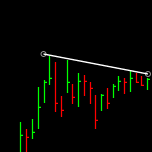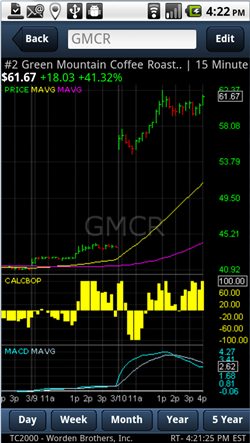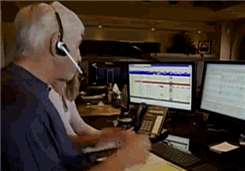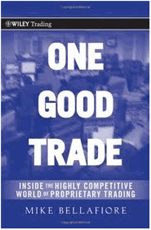Trend Line Entries: Tilted or Flat?
April 5, 2011 at 2:00 pm
I take a lot of trend line trades, as they give me a clear indication that price is either clearing an important level, or that it’s making a meaningful turn.
Recently I was asked why some of those trend lines are flat (lateral), and others are tilted. Additionally, I was asked how I determine my entries on each. Here’s what I said:
Whenever a trend line is slanted, I go with a break of the trend line itself. In the case of a bullish trend line break (a move above a descending trend line), I’ll place a buy stop just above the line itself, perhaps only a couple of pennies above it. These tilted trend lines are themselves the resistance for a stock, so once they’re broken, the stock tends to be free to move higher.

Whenever there’s a flat trend line of support or resistance, it’s evident that price is bumping up against a key zone which remains constant. Sometimes this is at a round number, like $100, but it doesn’t have to be. The way I trade these flat trend lines is to set a buy stop 10-15 cents past the resistance zone, as that will help to confirm I’m entering upon a true breakout that’s taking place rather than a brief penetration of only 1-5 cents which could prove to be a head fake.

When you’re drawing your trend lines, consider the overall situation. Is price struggling to clear a constant level? Use a flat trend line if so. If price is simply seeing a counter-trend pullback, then the pace of the pullback is better seen with a tilted trend line .
Trade Like a Bandit!
Jeff White
Producer of The Bandit Broadcast
Are you following me on Twitter yet?
Consistency Over Time
March 30, 2011 at 1:19 pm
 It’s been said that good trading is a marathon – not a sprint. I’ve said it too, because I agree. Overnight riches come to very few, but the truly successful usually earn it over time.
It’s been said that good trading is a marathon – not a sprint. I’ve said it too, because I agree. Overnight riches come to very few, but the truly successful usually earn it over time.
Think about it…it takes some time to learn this game, to get comfortable, to evolve to where you’re agile enough and have the discernment to switch styles or approaches when the situation calls for it. A newbie only does that out of desperation. In this game, experience pays.
Truth be told, March has been a tough month for me. I’ve been whipped out of some trades, bought some highs and sold some lows. Naturally, it has elevated my frustration level. The good news is that I’ve been here before. I’ve had those months where I have struggled, and every time I’ve been able to battle back – thankfully. This time should be no different.
I’ve looked over some trading results today, and it was a good exercise. I was reminded that there are occasional stretches where I give some back to the market. But they’re just little phases, and they’re inevitably followed by good runs – so long as I keep after it. I don’t have to make huge bets and get it all back in one trade, and I also don’t have to force trades in order to see my account back at highs. I simply need to keep a level head and persist.
Ask any distance runner, and they’ll tell you it’s all about maintaining a steady pace. The hills hurt, like losing trades, but you maintain your tempo and push through it. Cadence is important to cyclists, so they shift gears along the way in order to maintain that rhythm.
Similarly, you and I size up when we’re in the groove, just a runner takes longer strides going downhill or a cyclist shifts to high gear. When the road gets rougher or tougher on us, we scale back our size but we keep taking One Good Trade – that’s our job.
Trading at times feels like a fun run…achievement comes easy and you get the t-shirt as a bonus! At other times, it feels like an ultramarathon for which you aren’t prepared. Fortunately, we have the chance to rest along the way, and improve as we go. Attitude is key, as is taking a long-haul approach with our career as traders – even if we love short-term charts!
How are you running your race?
Trade Like a Bandit!
Jeff White
Producer of The Bandit Broadcast
Are you following me on Twitter yet?
Charting App for Android – Finally!
March 11, 2011 at 12:31 pm
 I became a smartphone user back in 2004, and for all this time I’ve waited for a charting app that was suitable for me. I’ve long been able to manage positions and place trades from my phone, but what’s been lacking has been a customizable, high-quality, dedicated charting app – until now.
I became a smartphone user back in 2004, and for all this time I’ve waited for a charting app that was suitable for me. I’ve long been able to manage positions and place trades from my phone, but what’s been lacking has been a customizable, high-quality, dedicated charting app – until now.
Worden has delivered excellent charting products for decades (I’ve been a Worden user since the 90’s), and now they have a charting app in the Android Market (iPhone app coming soon), TC2000 Mobile.
I downloaded it today, and it instantly exceeded my hopes for what it might do. I had expected to be able to punch in symbols and pull up a chart or customize the look of the chart or timeframe, but was blown away when I realized it has all of MY watchlists from TC already in there – AND all my chart templates!
A few of my favorite features:
- View your personal WatchLists in real-time
- Run your EasyScans with your custom settings on the go
- “Spacebar” through your WatchList charts by swiping right & left
- Read the evening Worden Reports
The newest version of TC2000 is a go-anywhere, access anywhere (desktop, browser, and now mobile app) version that’s getting better every week with added features and regular improvements. It’s just coming out of beta, and I’m thoroughly impressed with what it already offers.
Screenshots of the new TC2000 Mobile charting app:


The TC2000 Mobile charting app is available through Gold or Platinum service levels, so if you’re one of the many thousands of TC2000 users with an Android phone (or soon on the iPhone), this is a must-have trader app!
**Update: iPhone app now available in app store.
Trade Like a Bandit!
Jeff White
Producer of The Bandit Broadcast
Are you following me on Twitter yet?
Walking Away
March 3, 2011 at 3:31 pm
I caught Joey Fundora’s post today called It’s Okay to Take a Break From Trading. He brings forth some excellent points, so go check it out. And while Joey primarily addresses backing away when you feel you lack an edge (rightfully so) or when going on vacation, it got me thinking about the times when trading just becomes a little too important, and perhaps even a self-imposed staycation might be warranted.
When the Scales Are Tipping…
 Trading is one of those activities that can put you on top of the world, or completely bury you – if you allow it. And by “if you allow it,” I’m not referring to making or losing money. After all, every one of us will have some good trades and some bad trades – that’s not what I’m talking about. I’m talking about allowing trading to be the all-important activity in your life. If it’s sitting on that throne for you, then unfortunately, your daily satisfaction will hinge upon the color of your P&L.
Trading is one of those activities that can put you on top of the world, or completely bury you – if you allow it. And by “if you allow it,” I’m not referring to making or losing money. After all, every one of us will have some good trades and some bad trades – that’s not what I’m talking about. I’m talking about allowing trading to be the all-important activity in your life. If it’s sitting on that throne for you, then unfortunately, your daily satisfaction will hinge upon the color of your P&L.
That’s a really tough spot to be in. It magnifies your mood swings from day to day, and honestly, it’s not healthy. It’s no fun either. If you’re driven (as I am), the up day’s don’t carry near the weight in satisfaction as the down days tend to carry in dissatisfaction – regardless of if you’re making more than you’re losing. (Go back and re-read that sentence, because it’s a little confusing if you breeze through, but it’s of utmost importance.)
Stated otherwise, if I’m making good money on my up days and giving back only a portion of it on my down days, I’m net positive. But if I’m allowing my personal happiness to be based upon my performance today (or yesterday or tomorrow), I’m in for a world of hurt. I’m experienced, and I’ve been at this since the 90’s, so I have high expectations. Taking the aforementioned personal-satisfaction-based-upon-P&L approach, when I make money, I’m pleased but I expect to. When I lose money, I’m upset and the mood pendulum swings too far in a detrimental direction.
That’s a mistake which every one of us will at times make – but do not let it become a habit.
Work Hard & Let Go
Trading is hard. Really, truly difficult. Getting paid from your positioning takes real skill and experience, and that means you have to apply yourself to acquire those things. You don’t acquire them without true desire and hard work, which means you’re invested…with your time, your money, and often times your esteem on the line.
Just this week I had a day where I hit my peak of frustration. I didn’t smash any keyboards or scream at my computer or kick the dog, but I was running hot – and I hated it. I carried it with me, and later realized I’m giving trading too much weight. Yes, trading is what I do, and yes I have as strong of a desire to be successful at it as anyone else, but when I let a bad day bring me down the way I did, I’m giving it too much weight. Trading’s an activity, it’s not who I am. I have far too many other blessings in my life to place trading above them, but sometimes I need a reminder.
Maybe you need that reminder today as well – and here you go! Work hard with your trading, aim high, but keep it in its rightful place. As my buddy Bella says, Move On After a Trading Session. If you’re struggling to do that regularly, just walk away until you’re ready to return with a clear head and the proper perspective.
Trade Like a Bandit!
Jeff White
Producer of The Bandit Broadcast
Are you following me on Twitter yet?
4 Reasons to Be in Cash This Weekend
February 24, 2011 at 6:04 pm
 Last week, I closed out a few swing trades and shifted to cash. I’m glad. I’ve day traded and it’s been a good week, and I didn’t need to roll the dice overnight in order to turn a profit.
Last week, I closed out a few swing trades and shifted to cash. I’m glad. I’ve day traded and it’s been a good week, and I didn’t need to roll the dice overnight in order to turn a profit.
Heading into Friday, I think there are 4 good reasons to remain in cash over the weekend:
1. Busted Patterns. Simply put, right now for most stocks it’s too late to short (for the initial selloff anyway), and it’s too early to go long. For me, the smaller the pattern, the shorter the timeframe for the trade I’ll take from that pattern. With this week’s sudden shift of direction and the intensity of this initial pullback, whatever had been looking bullish (sans energy) now isn’t, and whatever had been looking bearish has cracked like the Liberty bell. Most patterns out there are 3-bar setups, which means I’ll day trade them if they confirm but otherwise will allow them to mature further (read: sit on your hands and wait).
2. Added Uncertainty. Heading into a 3-night, 2-day stay in the heart of Uncertaintyville isn’t great for capital preservation. Holding overnight always involves uncertainty, but when we’re in an environment which is so sensitive to geopolitical events in the Middle East, it has more of an earnings announcement feel to it. One of my trading rules dictates that I avoid holding positions into earnings since I have no edge, and because it makes risk management so difficult impossible. Right now, gap risk is running higher, so when the setups aren’t there (see #1 above), why hold overnight?
3. Change of Character. Every dip has been bought…until this week, which is to say the landscape has shifted a bit. That’s not bad, and it doesn’t mean the bull market is over. What it means is that the multi-hour pullback has been stretched into at least 1 multi-day pullback. We’re getting more back-and-forth, which is more commonly associated with a trading range than a trend. The market’s taking a much-deserved breather here at the very least, and we need to respect that.
4. Better potential ahead. There are a few setups I’m watching for Friday’s session, but the truth is that I expect much better opportunity to surface next week when it comes to swing trading. A couple of bars go a long way when patterns are developing, and right now that’s just what many stocks need. I expect we’ll see that take place next week, so I’d rather have the peace of mind and lack of risk than to fret over the weekend about what a potentially hurtful gap would mean.
Once the dust settles ‘over there,’ we’ll have some better patterns and spots to pick and choose from. And the good news is that volatility is increasing, which means more movement anyway – always a great thing for short-term traders like you and me. So enjoy your weekend and rest up, next week is sure to be another interesting one and we’re going to need to show up ready!
Trade Like a Bandit!
Jeff White
Producer of The Bandit Broadcast
Are you following me on Twitter yet?
Lessons From a Life-Long Speculator
January 26, 2011 at 11:43 am
 I caught a clip from a recent 60 Minutes interview in which a Las Vegas gambler named Billy Walters was profiled. This is a man who, at 64 years old, understands risk and edge as well as anyone. As a result, he’s been dubbed “the most dangerous man” by Vegas sports books.
I caught a clip from a recent 60 Minutes interview in which a Las Vegas gambler named Billy Walters was profiled. This is a man who, at 64 years old, understands risk and edge as well as anyone. As a result, he’s been dubbed “the most dangerous man” by Vegas sports books.
Walters has been a life-long speculator, betting on golf courses and in pool halls, and of course he wagers regularly on football and basketball games. He’s no stranger to streaks, having mentioned he’s been broke more times than he can recall, and yet the show stated he’s currently worth “hundreds of millions.”
The interview is embedded below, and you’ve got to see it, but before we get there I just want to point out a few things Walters clearly does exceptionally well. As traders, and therefore speculators in a different realm, we can all learn from him.
Success isn’t about making one big bet. Note in the clip below how Walters never lets it all ride on one game, instead he spreads out his capital across multiple opportunities. He’s confident in the outcomes, but by operating in different games and even different sports, he also helps to protect his outlay from unforeseen events. For the trader: don’t put your entire account into one idea.
Success goes hand in hand with passion. Walters’ net worth is said to be in the hundreds of millions, so why does the show depict him placing more bets of a few hundred thousand or mention he’s up $1M that week on his games? Because he’s passionate about it, he loves it. For the trader: if you don’t love the game, it’s going to be hard to get through the tough times and persist.
Get bigger when you have an edge. Over the years, Walters has increased his bets along with the expansion of his bankroll. But beyond that, when Walters sees a line that’s vastly different from his own, he bets very aggressively. He trusts his edge, and looks to exploit it most when that edge is biggest. For the trader: when your home-run setups come along with defined risk, size up.
Be creative. Walters used to be small enough he didn’t move the lines in the sports book when he placed his bets, but over time, he’s become a major player. That’s required him to adjust his system along the way, utilizing his team of associates to place bets for him. He also may push a line one way, then bet big on the other side. For the trader: don’t get stuck trading only one way, keep looking for a better approach.
Be persistent. A guy who claims he’s been broke many times clearly exemplifies persistence to not only still be in the game, but to be such a huge success. When the proverbial (or literal, in his case) chips were down, Billy Walters hung in there and kept fighting. He expected success, and he kept working until he got it. For the trader: stay in the game and don’t give up.
Surround yourself with sharper minds. Walters admits his team is made up of people who are all smarter than he is. That doesn’t mean he isn’t confident, but rather that he relies on others to provide assistance where he feels his skills are lacking. He’s no doubt the biggest success among them, but he attributes that to the bright people on his team. For the trader: if you’re not getting where you want to be on your own, get some help.
Play for meaningful stakes. One doesn’t amass a fortune by accident, and Walters hasn’t gotten rich by nickel-and-diming it along the way. He recognizes an opportunity, gauges the size of his edge, and then puts his capital at risk in expectation of a sizeable payout. For the trader: once you understand how to trade, allocate capital in such a way that you stand to make a fair amount when you’re correct – and never overtrade.
Here’s the clip:
Trade Like a Bandit!
Jeff White
Producer of The Bandit Broadcast
Are you following me on Twitter yet?
One Good Trade
January 21, 2011 at 12:23 pm
 I was sent a copy of One Good Trade by the author, Mike Bellafiore, longer ago than I care to admit. (In fact, Bella, please forgive me for taking so long to get around to reading it!) I will say though, once I picked it up, I only wished I had started reading it sooner.
I was sent a copy of One Good Trade by the author, Mike Bellafiore, longer ago than I care to admit. (In fact, Bella, please forgive me for taking so long to get around to reading it!) I will say though, once I picked it up, I only wished I had started reading it sooner.
Mike’s been a trader for just a little longer than I, so a few of his earliest experiences were before I got into trading back in 1998. From there, I really enjoyed his reflective tone regarding his trading career, experiences, mistakes, lessons, and successes. His honesty was refreshing, and I enjoyed seeing how he adjusted his approach throughout the market changes over the years (as we all must) in order to survive.
But beyond the nostalgia, One Good Trade was also full of wisdom. Mike’s personal trading experience was at the heart of the lessons he teaches in the book, but his experience and insights are compounded by those of the many traders at his prop firm. I started out in a day trading office – a very similar environment where I was surrounded by dozens of other traders for my first few years. I can tell you from my own experience, Mike still learns plenty from the other guys in his office. And it shows in the lessons he relays from having trained others over the years.
I want to hit 8 highlights I found in this book in order to give you a glimpse of what’s inside. Even though I’ve cherry-picked a few of my favorites to share with you, this is still a book you need to read if you’re an active trader (so go pick up a copy!).
1. Trading – like sports – is performance based. Athletes, like traders, understand that a little talent isn’t enough…it takes hard work too. Some days (or weeks) are better than others, so it’s important to show up ready to play, both physically and mentally. Bella’s recent example of MLB great Trevor Hoffman gives an excellent example of one such mental exercise for peak performance. Getting good rest is another way to ensure you can be at your best on a regular basis.
2. Maintain lists of the setups which work for you and those which don’t. This sounds so obvious, and yet have you ever done it? Trading responsibly includes knowing what works for you and which setups tend to fail or shake you out prematurely. Understand which is which, and as Gartman says, “do more of what is working, and less of what is not working.”
3. The market doesn’t care what you wish – so you must always adapt. It’s harsh truth, but something each of us needs to hear from time to time. Mike goes on to say that the market also doesn’t reward the trader seeking lazy trades, so be creative. These go hand-in-hand for the trader who is willing to adjust his approach as the tape requires.
4. You choose your attitude. This can be said for any endeavor, including trading. Go tell Lance Armstrong that attitude doesn’t matter. In trading, Mike reminds that you can complain and make excuses, or you can compete (and find ways to use current conditions to your advantage). There will always be obstacles to overcome (HFT’s, head-fakes, etc.), but never make excuses. Poor traders blame, so don’t be one of them if you want success in trading.
5. Make the most trades with the most size during the trading periods that statistically are most profitable for you. Another seemingly obvious statement, yet one which most traders simply don’t understand. You don’t have to be a statistics nut to appreciate the fact that for your trading style, there are times when you need to be active and times when you need to sit and wait. Find out when to do which, and you’ll stop giving back gains.
6. Work on your visualization abilities regularly. This is the best way to get better, best way to grow, best way to overcome challenges, and the best way to train your brain in the way you want to respond in any situation. Mike works hard with his professional traders to not only review their trades after the fact, but he harps on the importance of mentally rehearsing how to respond to various situations. That way, when the real deal comes along, the right preparation has been done.
7. Be coachable. Traders with a stubborn attitude or who don’t listen simply won’t improve, whether it’s what the market’s trying to tell you or something someone else is teaching you. If you aren’t a listener, you’re going to either stay stubborn (and lose) or you will take the long road to improvement. Those who are coachable are more able to place their ego aside and move forward, rather than adapting to what the market’s telling you (see #3 above).
8. Trading is all about skill development and discipline. Great traders obsess over doing their job, which is to make One Good Trade at a time. They always live to fight another day, and they’re continually developing their skills so they can trade any market which comes along. Discipline is shown both at their desk and away from it, and as a result, their hard work isn’t sabotaged by destructive habits.
Bottom line: Fantastic book, and it’s not to be missed if you’re a trader who is passionate about improving.
Trade Like a Bandit!
Jeff White
Producer of The Bandit Broadcast
Are you following me on Twitter yet?





